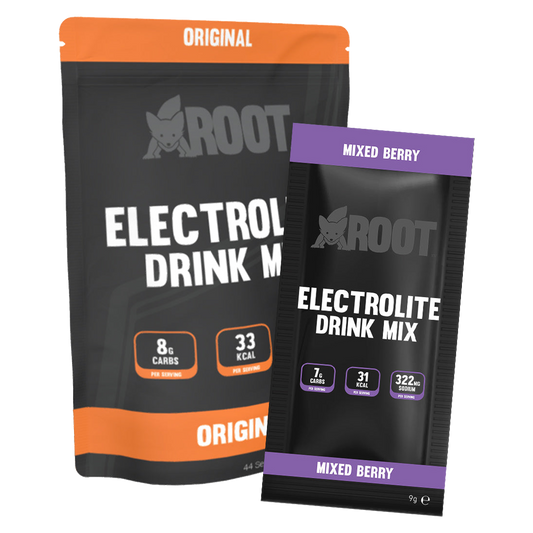
Lessons in Fuelling an Average Ultra Runner
Shopify APIEver wondered how an average ultra runner fuels during training and racing? David Taylor, 'an average ultra runner', provides tips and advice on staying fuelled up on long runs. Plus he gives a frank account of the ups and downs of his ultra running passion!
He is a 43-year-old ultra runner. Now past it in terms of football he found ultra running in his forties and has completed a number of ultra-marathons at different distances from 50k,100k and 154k in the last two years.
He is a husband to a very understanding wife, a dad to three girls and has a couple of mad dogs to keep him on his toes!:
I have no cartilage in my left knee, and to be honest, my right knee isn’t a lot better. I had my right achilles detached and reattached as part of a foot operation at the end of 2021. I am a bit overweight, tipping the scales around 90kg (I’m 5’11ish).
But do you know what? I love running.
So ultramarathons were the obvious thing right? I’m also still technically following doctors orders – I have still never run ‘a marathon’.
I kinda got addicted to running longer and longer distances…"
Nine months after my foot operation I ran my first 50K, three months after that my first 100k and then six months later took on the West highland Way, all 96 miles of it and finished in under 31 hours. Since then I’ve done another 50k, a 40 miler, a 100k and have my 2023 race calendar filling up. I’m stupid enough to sign up, stubborn enough to finish rather than having any real natural ability and although I have never been close to cut offs, I’ll be in somewhere in the bottom half of the field.
For this long stuff I have come to appreciate just how important fuel (food, calories, cakes) are to whether the race is fun or a brutal slog. I am an enthusiastic amateur and not a qualified nutritionist. This is my learning from my ongoing experiment of one. I have been consuming all the information I can on the subject. Here are my top tips:
1. BEFORE - Know when you need to start fuelling?
To be honest, as I'm used to doing longer stuff anything under 90 minutes and I don’t require fuel or water. As I run in the morning, I tend to do these runs in a fasted state. If it gets hard towards the end, then that’s great practice for when it will be hard in the longer races. You will possibly have heard of ‘fat-adaptation’ and all sorts of stuff while running fasted. I wouldn’t even bother – keep it simple.
You may require hydration and fuel if you run at the end of the day. Work out what’s best for you!
2. DURING - Know roughly what you need – but don’t be too precise!
There are so many calculators on the internet about how much you should eat, carbs per hour, how much salt you will need, especially if you are a salty sweater like me. Thing is, your body doesn’t really do precision – it may be having an off day, you may have a bug, you may have eaten something that works really well, or not.
The result is that, as annoying as this is, on any given day your body might decide to just be a bit different. That is (kin of)part of the fun, problem solving when things aren’t working.I did the River Ayr Way – a 40 mile race quite local to me. I was feeling confident, my previous two races had gone well. I calculated how much food and salt I needed in minute detail (I am pretty sure I even did a spreadsheet, I mean, for goodness sake).
The result –my stomach decided not to play the game – at 26 miles what had gone in decided to come out – which appeared to be everything that I had taken so no surprise I had the worst cramps I had ever experienced.
I think I tried to put too much into my body and likely to be the extra salt on top of what was already in my Active Root, not nice and (harsh) lesson learned. I did finish, an hour after I thought I would which also included bum-shuffling up some stairs during the race because of the cramp.
3. Test, test and test again
When training for an ultramarathon it makes sense that you are running a lot, especially on your weekend long run. But there is a lot of evidence that running past three hours isn’t that useful from a physiological point of view and also increases the risk of injury. So why do I keep longer efforts in my training blocks, with a 50k, 42 miler and 55 miler in the latest one.
Simply to practice what it will be like when I am completely drained, what food will go down. Is it gels, is it crisps, cake, sandwiches or some other form of kids party food? These longer efforts will also allow you the chance to practice eating early and running on a stomach with food (despite what your parents will have told you, it is actually OK). Even different brands of food might work better – so do in training what you will do in the race.
It not great for morale when you discover food X makes you throw up after 20 miles – so use the long runs as your laboratory.
At the moment, peanut butter and blackcurrant jam bagels with Active Root sports drink (Peppermint edition) is doing the trick.
So in summary, you need to do what works for you. Understand the principles behind what will get you through an ultramarathon but be prepared to experiment what works for you.





